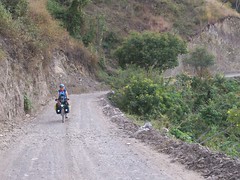Central America Blog (In Order)
Feel free to email send us a note with any questions or comments.
APLV: Home-Grown Leadership

Esteban Cantillano is one of the amazing success stories of APLV. In 1993 he was a campesino living in a little, remote village where APLV was developing a potable water project. He was elected the coordinator by the community, so was responsible for all the interface with the community. But he asked a pile of questions of the brigade from UC Berkeley that was putting in the system! He wanted to know about everything. He was eventually invited to join the first class of the "Potable Water Technical School", a technical high school program, but protested that he had only finished the 6th grade. They said "well, try it out - we'll take you on probation." That was in 1993. Needless to say, he finished with honors (and later went back and did his 7th-10th grade education!) and became one of the pillars of APLV. He has served in the technical/design role he was trained for, as the social coordinator (who does the contact with the village, local government, landowners, and the like), and is now in charge of the office here in Rio Blanco. He seems to know everybody, and to know everything about every project ever constructed by APLV.
Esteban is just one example of the depth of leadership that we've found here. All but one of the workers here is Nicaraguan, and they have a combined total of decades of experience with the organization. read more here... lee mas aquí... »
Agua Para La Vida: The Community does all the work!
(We'll have pictures and updates to this article in a couple of days.)
When a community gets interested in a water project and approaches APLV, it has to go through a number of steps before the project can become a reality. One of the first steps is to commit to doing all of the unskilled labor and provide hospitality to the APLV technical staff when they are onsite. Although APLV provides the materials and engineering, the community does an extremely difficult job - each family normally commits to between 42 and 62 days of labor for the project. You can imagine what that means to people who have very little to take that much time out of the course of a project (6 months to a year). The families build their own outhouses, and the men do all the trenching and the concrete work. This is a pile of work, as the piping often runs for 6-9 miles (10-15 kilometers).
If you're interested in more information on Agua Para La Vida or would like to contribute, they have an excellent website at APLV.org where you can get the whole scoop or make a contribution. It takes just $30,000 to $60,000 to fund a complete village project that may benefit 100-200 families, complete with potable water, outhouses, community health training, and reforestation planning. It is even possible to fund an entire project (and then visit for the inauguration of the project), but of course most of us give in smaller chunks. read more here... lee mas aquí... »
APLV: Reforestation and Environmental Work
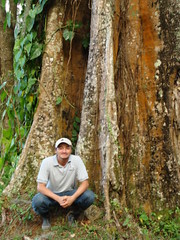
The second day we were in Rio Blanco at APLV in Rio Blanco Fadir Rojas, APLV's reforestation engineer, took us for a hike up into the beautiful Cerro Musún wilderness reserve right next to the town, where he used to work as an engineer and ranger. We spent the afternoon climbing up into virgin forest to a beautiful waterfall called Cascada Las Golondrinas (the swallows). As we walked along we chatted about his responsibilities with APLV and the growing importance of reforestation within the goals of the organization.
Fadir is from a purely campesino family in the dry, heavily populated western part of the country. His parents barely went to school - perhaps to the first grade - and can't really read, but they pushed education in their family and Fadir is one of four university graduates in his family. He succeeded in getting full scholarships for his university education at the national university and is now, at 27, one of the elite young leaders of Nicaragua.
When Fadir came to APLV he found that their vision of reforestation was too limited: They understood the idea of using forest management to project the water source from contamination, but the integrated management plan did not include enough emphasis on protecting the watershed itself from deforestation. read more here... lee mas aquí... »
APLV: Promoting Health and Sanitation
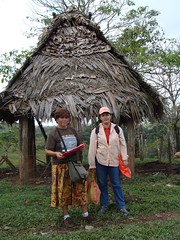
The organization we visited in Rio Blanco, Nicaragua, Agua Para La Vida, believes in an integrated approach to making a difference in a community. So they don't just drop a potable water system and disappear. They try to set up a program that will be self-sustaining and which can make a long-term difference in the health and welfare of the community. For that reason they always provide an outhouse (actually constructed by the family), and have a health team in charge of evaluating the community's needs, training them in appropriate health practices, and monitoring the water quality of the installed system.
Lilian Bando and Gregoria Espinoza have been working for APLV in their role as health promoters for a dozen years, and they still find that their educational role is the most important thing they do.
When they arrive at a new project, it's quite common to find that there are few or no outhouses (of course there are no sewage or water systems, so outhouses, where they exist, are the workhouses of sanitation in rural Central America). And it's also common to find that the entire community is ignorant of basic concepts like handwashing after going to the bathroom, proper management of drinking water, appropriate disposal of trash, and the like. read more here... lee mas aquí... »
APLV: The Potable Water Technical School
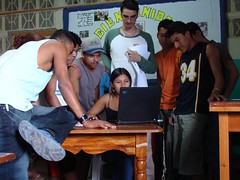
Agua Para La Vida is committed to truly sustainable solutions, and they have demonstrated it in the most significant way by actually starting a school for Potable Water Technicians.
The initial little tiny project that APLV did back in the 1980's, of course, was mostly done by brigades of volunteers coming down for a few weeks at a time. But when you do that, your project has little hope of being maintainable, because there is inadequate in-country expertise. To counter this, APLV started up the "Escuela Tecnica para Agua Potable", or Technical School for Potable Water back in the 1990's. It's a fully accredited 2+ year class involving every aspect of potable water design and development, including the theory and practice of planning and engineering the delivery systems and including everything else that APLV does with a project. Three classes have now graduated, and the fourth class (of 8 students) is about halfway through. For this class, 70 students from all over Nicaragua applied for the full-ride scholarship (including room, board, and tuition), and just the 8 slots were available. But what an education they get. They come out with all the mathematics and engineering to do technical work on water systems, and have a fully-accredited "Bachelor" degree, similar to an honors technical high school degree. Their presence in various organizations throughout Nicaragua means that projects don't have to spend money on high-priced consultants to do the work that these specialized technicians can do. APLV's "ETAP" school is the only school graduating water technicians in Nicaragua. read more here... lee mas aquí... »
We crossed into Costa Rica today
The Island of Ometepe, our last hurrah in Nicaragua

After riding back south from Rio Blanco in Nicaragua we spent one night at the tourist town of Granada, the port town at the north of Nicaragua. It's all full of tourists from all over the world, an easy gringo destination with a nice climate and beach and lake and great gringo services. Made us a little crazy though. In the morning we got on the 3-times-per-week ferry out to the island of Ometepe, in the middle of the lake. It took four hours and we got in after dark, but the next morning we found a beautiful island with a pair of dramatic volcanoes. We spent 3 days exploring and waiting for the ferry that would take us all the way to the bottom of the lake where we crossed into Costa Rica. If you ever want an easy place to get away from it all and spend a week or so with a really easy lifestyle, Ometepe is the place. So laid back and beautiful. Cheap. Good tourist services. Lots of hikes and things, and you're in the middle of a huge lake so there's lots of beaches and beachfront hotels. A very nice place.
APLV: Visits to actual communities getting water projects

We visited three impressive communities getting drinkable water in the Rio Blanco area. One was just in the preparation and funding stages, one was partly done, and the third was complete and beautiful, with a very remote community having clean, healthy drinking water 24 hours per day. I'll start with the one that was finished and work back to the one that was just about to get started.
Okawas
We had the delight of visiting the community of Okawás for the official ribbon cutting and handover ceremony for the new system. We got in a truck at 5;30 in the morning and drove for a couple of hours to a river crossing beyond which there was no road, crossed the river in a long motorized canoe, and then got on mules for the hour-long ride to the village. The trail started out pretty easy, but turned into some pretty impressive muddy and rocky ups and downs. With our little experience with horses we were a little nervous about how they were going to navigate the difficult terrain, but they did better than we would have. read more here... lee mas aquí... »
Nicaragua Tidbits
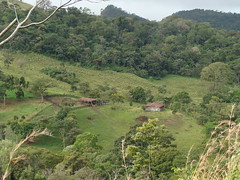
We found Nicaragua to be a delightful country. Despite the fact that all any of us remember about it is the war in the 80s and the US involvement in it, Nicaragua is a tranquil, safe, and friendly place. We didn't have to pretend that we weren't Americans... We were received with great friendliness everywhere we went. We found no vestiges of the 1980's socialist agenda, and museums were the only obvious physical relics of the wars.
We had heard various things about safety in Nicaragua, but what we found was a country where nobody seems worried about crime at all (except in Managua, which we didn't visit). Nicaragua is reputedly the safest country in Central America, possi bly including Costa Rica in that tally. Sometimes in Guatemala and Honduras when we would ask about a particular back road we would be warned off: "not enough people there, not enough police, dangerous", in Nicaragua we'd ask and they'd say "oh, yeah, that's great, no problems with delinquency here".
All this and Nicaragua is the most resource-poor country in Latin America, with a per-capita average income for the whole country of just $700 or so. We saw some pretty simple shacks, and there are far more outhouses in rural Nicaragua than there are flush toilets. There may not be any flush toilets in rural Nicaragua. read more here... lee mas aquí... »
Costa Rica: Just a quick visit

One of the delights of bike touring is that you spend most of your time in between big important tourism centers, instead of just going from one gringo hotspot to another. We get to meet ordinary people who are fascinated with us and have lots of questions and freely share their time and enthusiasm with us. And they are ordinary people who have not gotten jaded or tired of gringos or tourists. This is how the vast majority of our time in Mexico and Central America has been.
Then comes the famous tourist mecca of Costa Rica. Even though we've been here before, we didn't realize that the entire country has transformed itself into one huge vacation resort, almost an eco-Disneyland. We hardly passed a mile-long stretch in the whole country that didn't have tourist facilities and a sign in English. And we weren't in the main tourist part of the country! We probably didn't stay anyplace where there wasn't somebody that spoke English. Costa Rica is doing a fantastic job catering to tourists from all over the world, including all over Europe, the US and Canada, the Far East, and even places like Argentina. And there are no armed guards at the banks, which is a good sign. And it seems every town has a beautiful bakery where you can get fresh baked goods early in the morning. read more here... lee mas aquí... »
Into Panama - We're already in Panama City

We got to Panama from Costa Rica about ten days ago and have been working our way the (fairly long) length of the country.
We crossed an old railroad bridge to get across the border from Costa Rica on the little-used border crossing on the Caribbean - once again, no problems and no hassles, although we had to wait an hour or so for the single Panamanian clerk to get back from lunch or something.
From the border we rode another couple of hours to get to the pier for the water taxi to the main island of Bocas del Toro, a fantastic touristy area with lots of snorkelling and completely overrun with tourists. We had a very pleasant day snorkeling, seeing the brightest and most beautiful coral we've ever seen. Then we got back on a water taxi, went to the mainland, and started the ride through Panama.

In northern Panama we saw some amazing living situations - lots of shacks on the water, or in other areas on stilts. We rode through indigenous areas with people in more traditional clothes.
The second day out, we had the honor of doing our biggest one-day climb of the entire trip, over 6000 feet (almost 2000 meters). We crossed over the Continental Divide, hitting a maximum elevation of 4200 feet, and then descending the whole thing. The Caribbean side was mostly virgin rainforest, with waterfalls. read more here... lee mas aquí... »
(Our monthly email) Trip Update
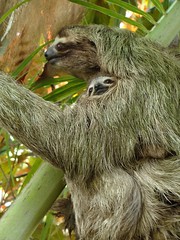
We arrived in Panama City about 10 days ago and are taking a break now before going on to South America. Nancy flew to California for three weeks to help out her dad, who has been ill. He's much better now, but her help at home is much appreciated. She'll be back in early April and we're planning to take a boat to Cartagena, Colombia to begin the South American chapter of our trip. (What, you say? "I thought you weren't going to Colombia?" Well, what we hear from everybody we've met and even from the US State Department is that Colombia has improved markedly in the last few years and is an absolutely wonderful place to visit. So we'll keep our eyes and ears open and go that way.)
We have pictures for you: Costa Rica and Panama pictures and Nicaragua Pictures
And the map of our Central America route is complete so you can see exactly where we went.
Immigration Paperwork
Well, today I had my first taste of official paperwork and such. To date, passing all those borders, we haven't had any issues or problems at all. None of those horror stories you hear about crossing borders in Central America. No bribes, no corruption, no paperwork. We had to wait an hour for the border official to come back from lunch in Panama. Not too bad.
But in Panama they (seem to) only give you 30 days in the country. It's marked very clearly on our paperwork. So since I'll be here a tad more than 30 days (with Nancy home helping her dad) I went down to the immigration office today to do the deed. I figured it would take a little time.
First I waited in a long line to get a number and they took my passport number and told me I had to go across the street and get copies of my passport, the entry stamp, and the tourist card, along with 2 photos of myself.
I went and got the copies and the pictures from the very busy little stand across the street.
Then I went back and looked at the "next serving" sign, seeing that it would be a couple of hours at least before mine came up. So I started asking around what I needed to do. They told me that I couldn't apply for the extension until I did the registration, and that I'd have to get and fill out forms for both registration and the extension. So I went and stood in the line for the copier, which is where you get the forms.
Then I went back across the street to buy a pen, and filled out the forms.
Then I went back in and started asking everybody who looked competent what I should do. read more here... lee mas aquí... »
Saludos de Panamá
Ya alcanzamos mas o menos la mitad del viaje. Hemos viajado en bici casi 16,000 kilómetros desde el inicio del viaje en Inuvik, Canada el 9 de Junio de 2006.
Llegamos en la capital de Panamá hace dos semanas y ya estamos descansando antes de continuar en America del Sur. O sea, Randy está descansandose. Nancy regresó por avión al estado de California, en los Estados Unidos, apra ayudar a su papá, quién ha estado enfermo (y que ya está mejorando). Ella está ayudando con toda su cuida ya que ha regressado a la casa del hermano de Nancy.
Nancy regresa en los principios de Abril y intentamos ir por bote a Cartagena, Colmbia, para empezar la parte de Suramérica. Originalmente no habíamos planeado visitar a Colombia por razón de la supesta inseguridad, pero hemos oido de muchos viajeros y otros fuentes que la situación ha mejorado bastate y que el país es maravilloso para visitantes. Claro vamos a tener cuidado.
Nancy's tips on riding the roads of Latin America
I wrote this in response to a letter of consternation from one of the few other women (and one of the very few other "mature" couples) riding a route like ours in Latin America. It seemed worth while sharing with you, my management technics on how I managed riding the roads of Latin America.
This intrepid rider sent a note saying that the roads of Mexico were freaking her out so she was hopping on buses to avoid certain stretches and was having a difference of opinion about the risk level of the roads with her husband. Here is my response, such as it is:
First of all, I do think you have great amount of courage and smarts and capabilities. I admire you on many accounts. Anyone that has ridden Copper Canyon the way you you did has my admiration. If I knew you better, I might be more comfortable telling you that you have balls.
In retrospect, after riding through Mexico, Guatemala, Honduras, Nicaragua, and Panama, my thoughts about riding in Mexico are that it is a difficult country to ride in, especially as you get closer to the cities. The bigger the city, the more aggressive the drivers, and less room for mistakes.
test entry - delete this
One of the delights of bike touring is that you spend most of your time in between big important tourism centers, instead of just going from one gringo hotspot to another. We get to meet ordinary people who are fascinated with us and have lots of questions and freely share their time and enthusiasm with us. And they are ordinary people who have not gotten jaded or tired of gringos or tourists. This is how the vast majority of our time in Mexico and Central America has been.
What I've been up to: Working for Agua para la Vida


Well, Nancy will fly back tomorrow from California (where her dad is quite healthy, gracias a Diós, and we'll get on a boat to Colombia.
What have I been doing for these three weeks? In some ways, nothing. Every morning I get up at the rather boring (and too expensive at $22/night) hotel where I've been staying, walk to a little Chinese restaurant where I have coffee and read the newspaper, and then I go sit down at the internet cafe for the entire day working on the new website of Agua para la Vida, the wonderful organization we visited in Nicaragua that builds rural drinking water systems. It has been a strange little interlude in a fairly uninteresting place, lonely of course without Nancy here (both as a friend and as our primary friend-maker!)
Anyway, Agua para la Vida now has a new Drupal-based website, with database-oriented features that allow a map of the sites they have built, reporting capabilities for donations, and the like. I could have been volunteering for them in Nicaragua for these three weeks and it would have been more enjoyable and social in many ways, but on the other hand the technology would have been a real challenge. Here I have decent, cheap places to work (there's even a 24-hour internet cafe) and good speed and quality.
But I'll be really glad to see Nancy tomorrow and continue on our way!
Panama City
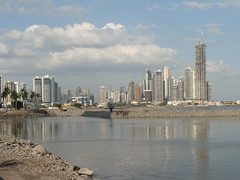
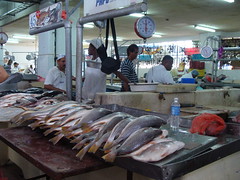
Panama City is certainly the most cosmopolitan place we've been in Central America, possibly in all of Latin America so far. Of course we've skipped a couple of the capital cities, like Guatemala City. But parts of the city are just full of skyscrapers and cranes, and there are gringos all over the place, and slick brochures about all the fancy condos you can buy in those high-rises. It really looks like Miami, and when you think about it, Panama City is probably giving Miami a run for its money. Miami used to be the big central point for rich Latin Americans to visit, with good shopping and comfort and luxury. But Panama City is so much more central, and has everything including the shopping, and is probably safer.... I'd say you should probably invest in Panama if you're the investing type.
Panama in general and Panama City specifically are also far more diverse than any place we've yet been in Latin America - approaching Panama City we saw several mosques. In my hotel there have been a number of traditional rabbis. And there is a vast array of skin colors, from Caribbean blacks to blonde gringos. And the Chinese seem to have the mini-super business sewed up throughout the country, and the cheap restaurant business in part of it.
But of course the rich fancy condos and diversity aren't the only story. This is a big city. There are beggars and some very poor people. You'll see the young men coming through on their rapid check of the street garbage containers checking for aluminum cans. But the sad thing is that there will be one guy coming right after another one... So there aren't enough cans to go around. read more here... lee mas aquí... »
Nancy's return back to Panama
I am back in Panama after spending 3 weeks playing nurse for my dad. I want to first thank all of you who wished my father a quick return to good health. I am positive all the warm wishes aided in his return to health and also return back to his own home in Boston.
It is amazing to see how sick he was and how his body was able to heal and how far he has come. My family gave me the nickname Nurse Ratchett, who was the nurse in the movie "One Flew Over the Cuckoos Nest". When I arrived to California, my brother Mark and I drove to the rehab center to bring my dad home to my brothers home. I had a 2 hour crash course on how to do more medical stuff than I ever thought possible.
Two days later my brother left for the week on a business trip. I was left to take care of my very sick dad. When he was released from the rehab center, he was on oxygen, insulin dependent, in a wheel chair, 15 different medicines, had bedsores and was still very sick. Every day he made incredible strides toward health. When I left him on April 6th, he was using a cane (when he remembered), no insulin, oxygen, and took 12 medicines a day and was in awesome health. My goal was to get him health so he could return back home in Boston. He is going home on the 10th with my brother Dan. I hope my dad continues to thrive when he returns back to his own home and does not have Nurse Ratchett telling him what to do.
It is very hot here in Panama and I can not wait to get to the highlands again where it is 30 degrees cooler. I have been having such intense hot flashes, I just about drowned myself. read more here... lee mas aquí... »
On the boat to Cartagena, Colombia



